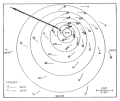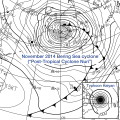Portal:Tropical cyclones
The Tropical Cyclones Portal

A tropical cyclone is a storm system characterized by a large low-pressure center, a closed low-level circulation and a spiral arrangement of numerous thunderstorms that produce strong winds and heavy rainfall. Tropical cyclones feed on the heat released when moist air rises, resulting in condensation of water vapor contained in the moist air. They are fueled by a different heat mechanism than other cyclonic windstorms such as Nor'easters, European windstorms and polar lows, leading to their classification as "warm core" storm systems. Most tropical cyclones originate in the doldrums, approximately ten degrees from the Equator.
The term "tropical" refers to both the geographic origin of these systems, which form almost exclusively in tropical regions of the globe, as well as to their formation in maritime tropical air masses. The term "cyclone" refers to such storms' cyclonic nature, with anticlockwise rotation in the Northern Hemisphere and clockwise rotation in the Southern Hemisphere. Depending on its location and intensity, a tropical cyclone may be referred to by names such as "hurricane", "typhoon", "tropical storm", "cyclonic storm", "tropical depression" or simply "cyclone".
Types of cyclone: 1. A "Typhoon" is a tropical cyclone located in the North-west Pacific Ocean which has the most cyclonic activity and storms occur year-round. 2. A "Hurricane" is also a tropical cyclone located at the North Atlantic Ocean or North-east Pacific Ocean which have an average storm activity and storms typically form between May 15 and November 30. 3. A "Cyclone" is a tropical cyclone that occurs in the South Pacific and Indian Oceans.
Selected named cyclone -
Hurricane Ida was a deadly and extremely destructive tropical cyclone in 2021 that became the second-most damaging and intense hurricane to make landfall in the U.S. state of Louisiana on record, behind Hurricane Katrina in 2005. In terms of maximum sustained winds at landfall (150 mph or 240 km/h), Ida tied 2020's Hurricane Laura and the 1856 Last Island hurricane as the strongest on record to hit Louisiana. The remnants of the storm also caused a tornado outbreak and catastrophic flooding across the Northeastern United States. The ninth named storm, fourth hurricane, and second major hurricane of the 2021 Atlantic hurricane season, Ida originated from a tropical wave in the Caribbean Sea on August 23. On August 26, the wave developed into a tropical depression, which organized further and became Tropical Storm Ida later that day, near Grand Cayman. Amid favorable conditions, Ida intensified into a hurricane on August 27, just before moving over western Cuba. A day later, the hurricane underwent rapid intensification over the Gulf of Mexico, and reached its peak intensity as a strong Category 4 hurricane while approaching the northern Gulf Coast, with maximum sustained winds of 150 mph (240 km/h) and a minimum central pressure of 929 millibars (27.4 inHg). On August 29, the 16th anniversary of Hurricane Katrina making landfall, Ida made landfall near Port Fourchon, Louisiana, devastating the town of Grand Isle. Ida weakened steadily over land, becoming a tropical depression on August 30, as it turned northeastward. On September 1, Ida transitioned into a post-tropical cyclone as it accelerated through the Northeastern United States, breaking multiple rainfall records in various locations before moving out into the Atlantic on the next day. Afterward, Ida's remnant moved into the Gulf of St. Lawrence and stalled there for a couple of days, before being absorbed into another developing low-pressure area early on September 5.
The precursor to Ida caused catastrophic and deadly flash flooding in Venezuela. Ida knocked down palm trees and destroyed many homes in Cuba during its brief passage over the country. Throughout its path of destruction in Louisiana, more than a million people in total had no electrical power. Widespread heavy infrastructural damage occurred throughout the southeastern portion of the state, as well as extremely heavy flooding in coastal areas. New Orleans' levees survived (unlike during Katrina), though power line damage was extensive throughout the whole city. There was also substantial plant destruction in the state. Numerous tornadoes were spawned by Ida as it moved over the Eastern United States. The remnants of the storm produced unexpectedly severe damage in the Northeastern United States on September 1–2. Several intense tornadoes and catastrophic flash flooding swept through the entire region, which had already been impacted by several tropical cyclones, Elsa, Fred, and Henri during July and August. The flooding in New York City prompted the shutdown of much of the transportation system. (Full article...)
Selected article -
The effects of Hurricane Georges in Cuba included $305.8 million in damages and six deaths. Forming out of a tropical wave over the Atlantic Ocean, Georges attained a peak intensity of 155 mph (249 km/h) on September 20, 1998. On September 23, the storm made landfall in southeastern Cuba as a minimal Category 1 hurricane. The storm tracked over the county for the following two days before emerging into the Gulf of Mexico on September 25 and later making landfall in the United States as a Category 2 hurricane. Before the storm's landfall in Cuba, officials reported that 200,000 people were evacuated to shelters; however, later reports indicated that upwards 711,000 people evacuated. A state of emergency was declared for much of eastern Cuba and most of the country was placed under a tropical storm or hurricane warning during the storm's passage.
More than 3,000 homes were destroyed and 60,000 damaged throughout the country, leaving an estimated 100,000 people homeless. Agricultural losses were severe, with the plantain crop loss estimated at 70% of annual production due to Georges, accounting for roughly $15 million of the total damages. Following the passage of the hurricane, several countries provided relief funds to Cuba for disaster recovery. Despite crop losses, affected residents were given essential supplies by the local government. By December, an estimated $90 million in funds was allocated for the impacts of Georges and the drought that preceded it. (Full article...)
Selected image -

Selected season -

The 1999–2000 South-West Indian Ocean tropical cyclone season was the first on record in which two storms – Leon–Eline and Hudah – struck Mozambique at tropical cyclone intensity, or with maximum sustained winds of at least 120 km/h (75 mph). The most notable storm of the season was Eline, which was the third longest-lasting storm on record in the basin. It lasted for 29 days while traversing the southern Indian Ocean, making the strongest landfall in decades along eastern Madagascar in late February. The storm was the first in a series of three storms that struck the country in early 2000, along with Gloria in March and Hudah in April. Collectively, the three storms killed at least 316 people. The season started on November 1, 1999, and ended for most of the basin on April 30, 2000; for Mauritius and the Seychelles, the season continued until May 15. These dates conventionally delimit the period of each year when most tropical cyclones form in the basin.
Despite the destructive nature of the season, it began later than usual. Cyclone Astride originated toward the end of December, bringing rainfall and gusty winds to northern Madagascar while in the region. In January, Cyclones Babiola and Connie both formed east of Madagascar and took southerly tracks. Connie passed near Réunion island, producing 1,752 mm (69.0 in) of rainfall in the mountainous peaks and killing two people. Eline, the longest lasting storm of the season, struck Mozambique while the country was experiencing its worst flooding in 50 years, collectively causing around 700 deaths and about $500 million in damage. The storm also killed 12 people in Zimbabwe and 21 in South Africa. Just two weeks after Eline struck Madagascar, Tropical Storm Gloria affected the same general region, bringing additional deaths and damage. Cyclone Hudah in April was the strongest storm of the season, reaching peak 10‑minute winds of 220 km/h (140 mph). It caused three deaths in Mozambique, although its effects were worse in Madagascar, where there were 111 deaths. The final storm of the season was Tropical Storm Innocente, which dissipated on April 24. In addition to the named storms, there were four unnamed tropical disturbances or storms, as well as one subtropical cyclone that formed in the southern Mozambique Channel.
(Full article...)Related portals
Currently active tropical cyclones
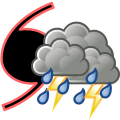
Italicized basins are unofficial.
- North Atlantic (2025)
- No active systems
- East and Central Pacific (2025)
- No active systems
- West Pacific (2025)
- No active systems
- North Indian Ocean (2025)
- No active systems
- Mediterranean (2024–25)
- No active systems
- South-West Indian Ocean (2024–25)
- No active systems
- Australian region (2024–25)
- No active systems
- South Pacific (2024–25)
- No active systems
- South Atlantic (2024–25)
- No active systems
Last updated: 03:16, 1 June 2025 (UTC)
Tropical cyclone anniversaries

June 1,
- 2007 - Tropical Storm Barbara (pictured) starts weakening as it was reported that it had damages a total of US$55 million and killed 4 people.
- 2025 - The Central Pacific and Atlantic hurricane seasons officially begin.
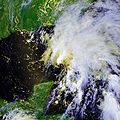
June 2,
- 2003 - Severe Tropical Storm Nangka reached its peak intensity to the south of Taiwan.
- 2007 - As a rapidly weakening storm, Tropical Depression Barry (pictured) makes landfall over in Florida before transitioning into an extratropical cyclone. Barry only killed three people in its path with damages of only $118 thousand.
June 3,
- 1982 - Tropical Storm 02B made landfall in India near Paradip, killing 140 people and destroying half a million homes.
- 2010 - Cyclone Phet struck eastern Oman, dropping heavy rainfall across normally arid areas; the storm killed 47 people and left US$861 million in damage.
- 2014 - Tropical Storm Boris makes landfall over in Southwestern Mexico as a weak system, killing a total of six people and US$46.8 million worth of damages.
Did you know…




- …that the Joint Typhoon Warning Center considers that Typhoon Vera (pictured) of 1986 is actually two distinct systems, formed from two separated low-level circulations?
- …that Cyclone Freddy (track pictured) in 2023 was the longest-lasting tropical cyclone recorded?
- …that the typhoons of 2024—Yinxing, Toraji, Usagi, and Man-yi (pictured)—made history as the first recorded instance since 1951 of four tropical cyclones coexisting in November?
- …that Hurricane Otis (pictured) in 2023 was the first Pacific hurricane to make landfall at Category 5 intensity and surpassed Hurricane Patricia as the strongest landfalling Pacific hurricane on record?
General images -
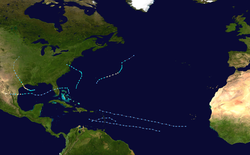
The 1983 Atlantic hurricane season was an event in the annual tropical cyclone season in the north Atlantic Ocean. It was the least active Atlantic hurricane season in 53 years, during which four storms formed. The season officially began on June 1, 1983 and ended November 30, 1983. These dates, adopted by convention, historically describe the period in each year when most systems form. The first named storm, Hurricane Alicia, formed on August 15. The last storm of the season, Tropical Storm Dean, dissipated on September 30.
This season produced seven tropical depressions, of which four became named storms; three attained hurricane status, of which one became a major hurricane, a storm that ranks as a Category 3 or higher on the Saffir–Simpson scale. The most notable storm in 1983 was Hurricane Alicia, which killed 21 people and caused $2.6 billion (1983 USD; $5.6 billion 2008 USD) in damages, making it the costliest storm, at the time, in Texas history. As a result of its intensity, the name Alicia was subsequently retired from reuse in the North Atlantic by the World Meteorological Organization. Another notable storm, Hurricane Barry, made landfall on Florida as a tropical storm, then, after crossing into the Gulf of Mexico crossing, strengthened into a weak Category 1 hurricane that traveled almost due west across the Gulf before making landfall in extreme northern Mexico. (Full article...)
Topics
Subcategories
Related WikiProjects
WikiProject Tropical cyclones is the central point of coordination for Wikipedia's coverage of tropical cyclones. Feel free to help!
WikiProject Weather is the main center point of coordination for Wikipedia's coverage of meteorology in general, and the parent project of WikiProject Tropical cyclones. Three other branches of WikiProject Weather in particular share significant overlaps with WikiProject Tropical cyclones:
- The Non-tropical storms task force coordinates most of Wikipedia's coverage on extratropical cyclones, which tropical cyclones often transition into near the end of their lifespan.
- The Floods task force takes on the scope of flooding events all over the world, with rainfall from tropical cyclones a significant factor in many of them.
- WikiProject Severe weather documents the effects of extreme weather such as tornadoes, which landfalling tropical cyclones can produce.
Things you can do
 |
Here are some tasks awaiting attention:
|
Wikimedia
The following Wikimedia Foundation sister projects provide more on this subject:
-
Commons
Free media repository -
Wikibooks
Free textbooks and manuals -
Wikidata
Free knowledge base -
Wikinews
Free-content news -
Wikiquote
Collection of quotations -
Wikisource
Free-content library -
Wikiversity
Free learning tools -
Wikivoyage
Free travel guide -
Wiktionary
Dictionary and thesaurus





